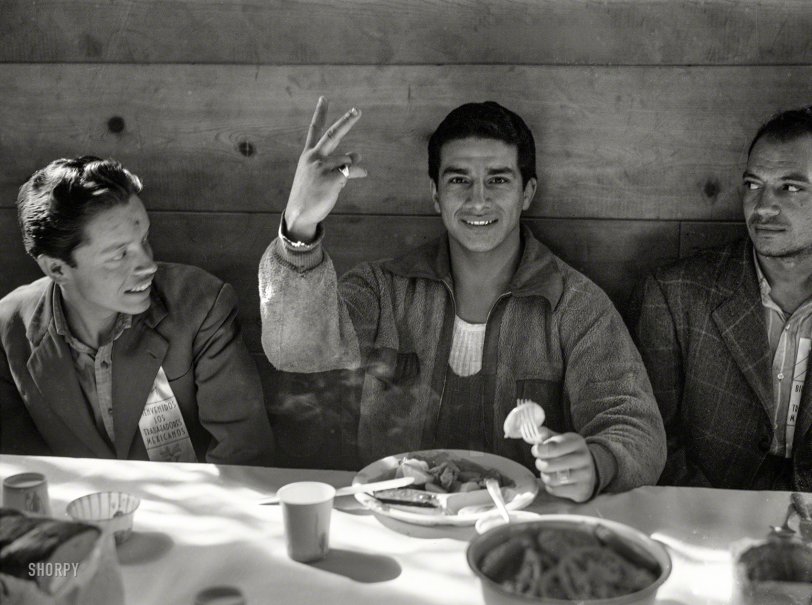


Framed or unframed, desk size to sofa size, printed by us in Arizona and Alabama since 2007. Explore now.
Shorpy is funded by you. Patreon contributors get an ad-free experience.
Learn more.

- Freeze Frame
- Texas Flyer wanted
- Just a Year Too Soon
- WWII -- Replacing men with women at the railroad crossing.
- Yes, Icing
- You kids drive me nuts!
- NOT An Easy Job
- I wonder
- Just add window boxes
- Icing Platform?
- Indiana Harbor Belt abides
- Freezing haze
- Corrections (for those who care)
- C&NW at Nelson
- Fallen Flags
- A dangerous job made worse
- Water Stop
- Passenger trains have right of way over freights?
- Coal
- Never ceases to amaze me.
- Still chuggin' (in model form)
- Great shot
- Westerly Breeze
- For the men, a trapeze
- Tickled
- Sense of loneliness ...
- 2 cents
- Charm City
- What an Outrage
- Brighton Park
Print Emporium
Trabajadores Mexicanos: 1943

May 1943. "Stockton, California. Mexican agricultural laborers who have come to help harvest beets eating their lunch." Medium format nitrate negative by Marjory Collins for the Office of War Information. View full size.
Mexican workers in Walla Walla
My grandparents' farm had a cabin a ways from the house. It was never in use when I was around, but was there for the Mexican laborers who came to help harvest the wheat and sugar beets. They did some cooking for themselves, including making tortillas, but Grandma would always cook more of whatever was for dinner and send half of it out there.
It's always seemed like an awful long way to go, from Mexico to Washington, but they obviously made enough money to be worth traveling the distance. I know they were still doing it, in the early 1970s, when Grandpa retired from farming, and I assume it's still going on. There was also a site, in town, with barracks like housing, and other facilities for those who didn't work on a farm that had housing for them.
Memories of my father
My father was 18 when WWII broke in Europe. Many times he explained to me what was the mood in northern Mexico when this happened. For instance, many of his friends moved to California for agricultural jobs, in fact, there was a US-Mexico workers program, the "bracero program", on which workers where allowed into jobs and many of them eventually joined the forces to gain US citizenship.
Today, when it is easy to hear and read about many misperceptions on Mexican immigration, my old man's voice comes quite clear: there is no way to unthread a thread that has been part of the fabric for so many years.
"Welcome Mexican Workers"
My, how far we have come since then.
Flicking the V
I enjoy it when photos like this serve to document items that I expect to be more modern than the photo proves them to actually be. In this case, the now-ubiquitous triple compartment disposable plate, decorative paper cups, and the fleece material of his jacket are things I wouldn't necessarily expect to have seen from 1943. Even his haircut suggests that if you were to see only the vertical center third of this photo, it would be difficult to say it was not taken 50 or more years later. The mass-produced satin ribbons themselves seem only slightly anachronistic to me in and of themselves, but I am a little surprised that such resources would have been allocated during the war to produce a ribbon to simply welcome Mexican laborers.
By the way, good thing he's Mexican rather than British, or this photo might be rather offensive.
























On Shorpy:
Today’s Top 5